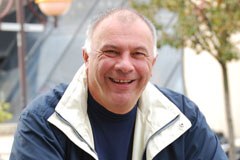News
"We'll keep at it."
Jul 13, 2012
/
CIPRA Internationale Alpenschutzkommission
Virtually everyone was there. Idrija's festival hall was packed to the rafters, and the youth symphony orchestra summoned specially for the occasion was in full flow. There was plenty of drama, and the TV people were there, too. A murmur went through the 1,000-strong audience as they got to their feet and began clapping. Then a large burly man in a dark suit walked onto to the stage. Deep creases bracketed his laughing mouth like waterfalls, stretching up to his white temples. Bojan Sever, the major of the small Slovenian town in the alpine foothills, held aloft the certificate confirming their status as Alpine Town of the Year 2011. Cameras flashed and the applause redoubled. That was just over a year ago.

Image caption:
Ecologically mobile: Mayor Bojan Sever intends to make Idrija a great place to live. © Madeleine Rohrer / CIPRA International
In the meantime the town, which with a population of 6,000 inhabitants has precisely 80 unemployed, is one of five pilot regions in the Alpstar EU project, the purpose of which is to make the Alps a carbon-neutral region. Bojan Sever firmly believes that Idrija has sufficient biomass to become self-sufficient with green energy. The necessary infrastructure is already being built.
Achieving carbon-neutral status is one of the main objectives of the Alpine Town of the Year Association. For Idrija, receiving the title sent out a powerful signal - both within the community and beyond. Long-held projects were tackled and new ones planned. "When I first heard of the network, I knew the title would be good for Idrija," says the 56-year-old. Together with his colleagues, the horse breeder and former technical manager of a domestic world market leader for electronics travelled first to Bolzano, then on to Bad Aussee, both Alpine Towns of the Year. "There we realised that Idrija also needed a strategy for a sustainable future."
Idrija's geographic and geo-political remoteness has always shaped its inhabitants. For 500 years it owed its livelihood to mining. Until the late 1980s it was home to the world's second largest mercury mine. The mine should soon become a UNESCO World Heritage Site - if the mayor has his way. He is said by some to be stubborn; by others, cunning. Be that as it may, Idrija has seven other EU projects on the go besides Alpstar - and in 2011 it received an award for sustainable tourism from Brussels. The fact that he has been unable to win over any other Alpine Towns for one of his EU projects has dampened Bojan Sever's spirits somewhat. "They're all a little timid." He certainly feels they ought to give it a try. "Previously we used to have an eco-day here; now as Alpine Town of the Year we have a whole ecological week." Ten years from now his town will be a place where the living is good, attracting international corporations. Bojan Sever is in no doubt that Idrija owes its revival and upturn first and foremost to its inhabitants. "The Alpine Town of the Year has shown that everyone here is keen and capable of doing something for a better life. So we'll keep at it."
Madeleine Rohrer (text and photo), CIPRA International
Achieving carbon-neutral status is one of the main objectives of the Alpine Town of the Year Association. For Idrija, receiving the title sent out a powerful signal - both within the community and beyond. Long-held projects were tackled and new ones planned. "When I first heard of the network, I knew the title would be good for Idrija," says the 56-year-old. Together with his colleagues, the horse breeder and former technical manager of a domestic world market leader for electronics travelled first to Bolzano, then on to Bad Aussee, both Alpine Towns of the Year. "There we realised that Idrija also needed a strategy for a sustainable future."
Idrija's geographic and geo-political remoteness has always shaped its inhabitants. For 500 years it owed its livelihood to mining. Until the late 1980s it was home to the world's second largest mercury mine. The mine should soon become a UNESCO World Heritage Site - if the mayor has his way. He is said by some to be stubborn; by others, cunning. Be that as it may, Idrija has seven other EU projects on the go besides Alpstar - and in 2011 it received an award for sustainable tourism from Brussels. The fact that he has been unable to win over any other Alpine Towns for one of his EU projects has dampened Bojan Sever's spirits somewhat. "They're all a little timid." He certainly feels they ought to give it a try. "Previously we used to have an eco-day here; now as Alpine Town of the Year we have a whole ecological week." Ten years from now his town will be a place where the living is good, attracting international corporations. Bojan Sever is in no doubt that Idrija owes its revival and upturn first and foremost to its inhabitants. "The Alpine Town of the Year has shown that everyone here is keen and capable of doing something for a better life. So we'll keep at it."
Madeleine Rohrer (text and photo), CIPRA International

